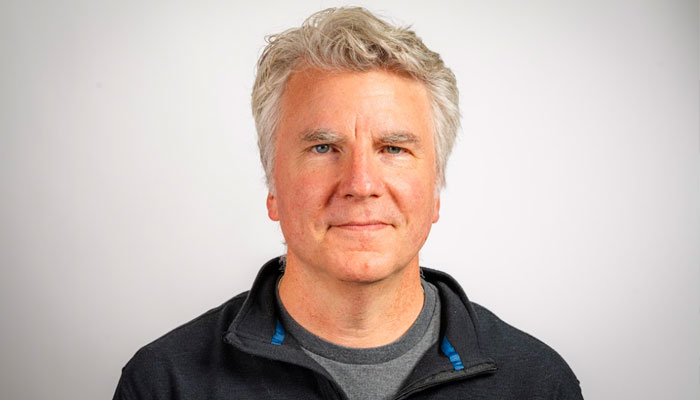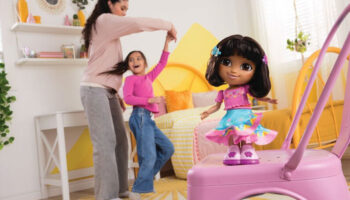Readyland’s Joshua Garrett on unlocking the magic of voice tech in play

Josh, I’m delighted to connect. For anyone new to Readyland and your series of voice-tech infused books, how would you describe them?
They are currently real, physical books that work with our Alexa skill to create an amazing, interactive book experience. On every page the story is brought to life through wonderful, magical audio interactions, filled with sound effects and music. Kids get to choose their adventure, which makes it a different experience almost every time.
Interactions in what sense?
Kids can actually talk with the characters, play games and make choices that affect the story. For example, they might see a yard full of things and the character will stop and ask: “Tell me something you see.” The reader can name anything, and the character will talk about it and engage the child to create a deeper connection to the story.
Kids can also play games with the characters, like I Spy or 20 Questions. They can make music; for example, choosing which character is the lead singer for the band. It’s an audio driven AR world built around a physical book. It adds an entirely new dimension and interaction to the traditional reading experience, with no screens.
And every time you read a Readyland book, you can make different choices. There are hundreds of choices in each book, creating millions of combinations of paths through each story. The amount of play and content is unlike anything I’ve worked on before.
It sounds exciting. There’s a video here showing the books in action.
So, how did the idea for this come about?
Like many of the best ideas, it came through collaboration. My company, Creativity Inc, had been doing a lot of work in Alexa skills and Google actions, developing interactive voice projects for major kids brands.
I’ve had a long standing relationship with Dave Capper, an absolute genius and true visionary… He helped build the original He-Man and Koosh into mega brands and invented top selling toys like HitClips, Video Now and ToothTunes. Dave and I started talking about voice tech and what it could do and we hit on the idea of good old-fashioned books. We saw an opportunity to take something so wholesome and beneficial to a different level.
We made a prototype, and then tested it with kids. I still remember the first child so clearly – we were blown away by their reactions to it and how magical and robust it could be if you designed it well. Seeing that, we went all in to create a whole new way to interact with traditional books and stories.
When you’re creating one of these books, do you start with a story or with the interactive moments that you want to build a story around?
It depends. When we start with a known story, like Jack and the Beanstalk, we look for places where a child can get involved, interact with a game, or help a character make decisions. For example, there’s a point where Jack gets caught by the giant, and the child gets to decide how Jack should try to escape, whether by tickling the Giant, trying to scare him, or something else. What’s so great about Readyland is that each time through, the child can make a different choice with a different outcome.

When we create a new story, such as our Rosie & Ricky books, we start with the experiences and what would be fun for kids. Do we want to incorporate I Spy? Do we want a musical interaction? Do we want kids to choose ingredients to make a smoothie? The story creation and the experiences we want to include really go hand in hand.
As an example, we decided it would be cool to let a child choose their own path through the pages of a book. So, we designed A Trip to the Park with Rosie & Ricky to let the reader decide how they want to go through the story. Instead of going page-by-page in order, you can choose where to go next and the audio will guide you to the right page. It’s like being at a park and seeing the map and deciding how you want your adventure to go.

Did you come into this already aware of challenges around designing for Alexa, or the myths around the challenges of designing for Alexa? Or was it an education of sorts?
We were fully aware and well equipped to deal with the design challenges. We had been working closely with the Amazon Alexa team for a while, including developing cutting-edge applications leveraging our amazing access to new technologies. We also brought decades of experience in making intuitive, simple to use kid’s experiences which played an important part in how we developed concepts around Alexa. And on top of that, we test and test and test. It’s not just technology for technology’s sake, what’s most important is to create a compelling and engaging experience for kids that they will want to visit over and over again.
I imagine voice tech is evolving quite rapidly. How do you embrace that and develop product that ‘keeps up’?
We’re really proud of our extensive experience with audio and interactive products, and we always work to keep things current and engaging. We back everything with testing to make sure the experience is seamless and robust. Alexa skills are great in that users never have to update anything. If we decide to make a change, we flow content to the user with no effort on their part. We can test new ideas and technologies to determine whether it makes for a better user experience. We can then implement and adapt quickly if we notice any issues or opportunities. Our litmus test for change is always whether it benefits the audience.
For instance, we’ve incorporated an amazing reading evaluation technology for when a child decides to read the words themselves. We don’t force that; we make it an option. We work hard to make it fun and not feel pedantic. Like everything we do, we test to ensure all works as intended and is a great user experience before ever rolling it out.
As for evolution, AI is obviously on everyone’s minds right now. We’re excited to be actively working on how we can use AI to make a wonderful experience even better!

Do you think there are misconceptions out there about tech-enabled products that sway what people in, say, retail buying positions might make of these sorts of launches?
Right now, we’re very lucky to have Amazon as our primary partner. As both a retailer and technology company, they’ve contributed technically and creatively to Readyland and our latest book, Owl & Dragon, which brings to life their Owl and Dragon designed Echo Dot characters in an all-new adventure. Ultimately, we believe that when technology is seamlessly integrated into engaging experiences, customers will want them and retailers will support them.
How has the world of publishing reacted to this range? I imagine voice-tech enabled books are quite a jolt of innovation.
Both the toy and publishing industries have certainly taken notice. And while we’ve seen noticeable differences between them, both industries care passionately about the power of story, and keeping their characters, stories, properties, and brands relevant for their audience. And that’s exactly our sweet spot, and where we can make a real impact in both the toy and publishing industries.

It sounds like a mighty opportunity. Now, you mentioned Owl & Dragon earlier; let’s dive into that. How did go about building a story around these two Echo Dot characters?
The Alexa team who supported the launch of Readyland books were also responsible for developing the Owl and Dragon Echo Dot Kids characters, and they had lots of great ideas around who these characters were. We worked with them to understand Owl and Dragon, their motivations, their personalities, their friendship. We then crafted the story around that relationship – and Amazon was involved every step of the way. With each of our books, we try to do a little more than we did before. With this one, we incorporated a whole new level of music and ambient sounds. We’ve made a really cinematic experience, which is still fully interactive. And we’re looking forward to working with other partners across different industries to do the same with their IP.
And background music – like with movies – can do a lot of the heavy lifting when it comes regards to things like tone and action. But creating sounds for a fantastical world, and a creature like a dragon, must be a fun creative challenge?
Absolutely – and it’s something we do incredibly well. Over its history, Creativity Inc. has created many of the magical, sparkly sounds for every princess you know and space sounds for the most popular sci-fi brands in the industry. We have brilliant sound designers who have created breakthrough audio for the biggest global brands for decades. We leveraged all of that creative experience when producing what the dragon’s flames sound like, or the ambient sounds in Fairy Corner.

Owl & Dragon nods to this, but do you see lots of scope for brand collaborations? It seems a great avenue to tell licensed stories.
1000%. We’ve already had great discussions with some of the top licensors who have expressed a ton of excitement about kids more deeply interacting with their characters and stories in a new way. Right now, we’re exploring many different avenues. Honestly, we’re not at a loss for ideas for ways Readyland can deliver incredibly deep experiences for kids and adults alike, we just have to decide which one to do first.
How do you have ideas Josh? What helps fuel your creativity?
For me, creative thinking is a process that runs in the back of my head. If I have a design challenge, there’s a gestation process which I’ve found to be pretty reliable in terms of generating ideas. I trust that process, and then when the edges of a solution start to become clearer, I start to write. The act of sitting and writing really helps it take shape.
Brainstorming with other people is also important. It helps me to articulate my thoughts more clearly, and then other supporting or opposing thoughts help shape it. Working with talented people is critical, and I’m so lucky to have worked with some of the most talented folks in the toy industry for decades.
And this may sound counterintuitive, but having limitations is also very helpful. Part of the reason I’ve thrived in toys is because there are so many boundaries. Blue-sky thinking is tougher for me, I’m always thinking about the reality of the execution. Having a target – whether that’s a schedule, a budget, technical limitations, or the specific parameters of what we’re going for – sparks creativity for me. It’s about knowing where the limits are, pushing them as far as I can, and then finding creative solutions that make it seem like the limits aren’t there at all. It’s like creating an amazing magic trick.
Do you think voice tech still has scope to shake up the toy and board game industry?
Absolutely. Once people experience how integrated the technology and play can be, things will change. Many experiences have had issues in the past, including some that we’ve worked on, whether that’s lag or feeling like the voice interaction is an intrusion into the experience. What we’ve developed, starting with books, is an experience that’s seamless, intuitive, incredibly engaging, and has just the right amount of magic sprinkled in. We think it can become a new medium for expressing an IP, including for the toy and game industry.
Looking ahead, what does 2024 hold in store for Readyland?
More books, and even going beyond publishing! We have one of the most extensive histories of working with companies, licenses, and brands to bring new magic and consumer enthusiasm to their properties. And it’s just the beginning. I can’t say too much, but we’ll have lots of news to share about the future of Readyland very soon.
Before we wrap up, was working at this cross-section between tech and play always in the cards, or did one come first?
When I was a kid, tech and play were critical to the things I found fun. I grew up in the late 70s/early 80s, and we had one of the first home computers. There was nothing you could do with it other than programming, so I learned how to do that. I loved making games and story-based experiences, like the early text adventures (Colossal Caves and Zork). I didn’t realise it back then, but the intersection of story, tech and play were important parts of my younger life.
When I finished school, I became a professional musician. I earned my doctorate from the Julliard School and was a successful French horn player and teacher. I played around the world with some of the great orchestras, like the San Francisco Symphony, and Israel Philharmonic. I even got to play with Metallica! Lots of fun stuff. Then, when I was 30, I switched careers and started making toys. It’s felt like going back to my childhood, which has been wonderful.
Are there parallels between your creative process in this industry and what you used to do as a French horn player? It’s not an obvious link!
It seems so different, but there are strong parallels. The biggest one is story. As a musician, you’re on stage telling a story through music. You strive to bring the audience along with you, keeping them fully engaged every step of the way. Designing toys is very similar in that you’re creating a story experience, but one that is interactive. You work to keep kids fully engrossed in this story through fun and engaging experiences, and you stay away from anything that will disturb it, like anything unintuitive or glitchy. The great composer Gustav Mahler once said “To create a symphony is to create a world” and I feel exactly the same way about making products for children.
Fantastic. Josh, a huge thanks again.
–
To stay in the loop with the latest news, interviews and features from the world of toy and game design, sign up to our weekly newsletter here






















